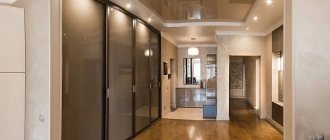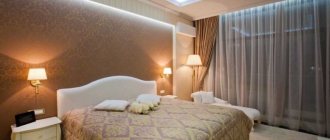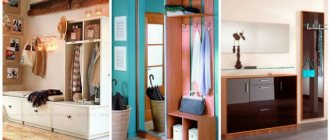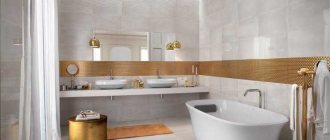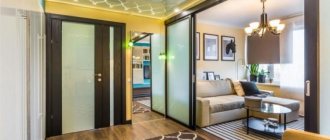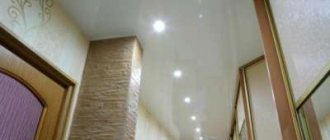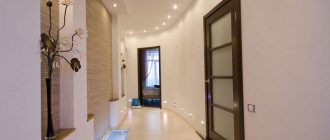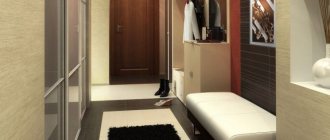The hallway is the place where the energy of the street and the energy of the house come into contact. From here a person goes out into the world and returns here in the evenings. This is where guests are greeted and get their first impression of the hosts’ tastes. Therefore, when designing a corridor, you must combine both functionality and beautiful design.
And if the first part of the question is more about the floor, walls and filling, then the second very, very much depends on how well thought out the design of the ceiling in the hallway is. Properly designed, it can greatly embellish a room, highlight its advantages and hide its shortcomings.
Forms and types
Ceiling coverings can be simple or suspended. In the first case, they are applied or attached directly to the base. In the second, they need to build a special frame. Simple ceilings are obtained by whitewashing or painting the surface, gluing wallpaper or polystyrene foam boards onto it. Their shape, in most cases, is a perfectly flat surface.
For suspended ceiling structures, transformations are limited only by the range of the designer's imagination. In addition, it is possible to construct both one-, two-, and multi-level systems.
Types of suspended ceilings:
- Plasterboard.
- Tension (mounted).
- Cassette.
- Rack and pinion.
- Hemmed.
The shape and type (or combination of several) ceiling structures are selected depending on individual taste preferences, budget for renovation, as well as architectural and other features of the room.
Materials and finishing options
The abundance of modern technologies and finishing materials makes it possible to construct both simple, unpretentious and technically complex, multi-level, intricately geometric ceiling structures in the corridor. And having understood the intricacies of the ceiling covering, its advantages and disadvantages, it becomes much easier to make the right choice. Let's look at them in more detail.
Whitewashing and painting
Against the background of the relative cheapness of materials, these options for finishing corridor ceilings are significantly inferior due to their fragility and the length of time the work takes to complete. Indeed, in this case, almost perfect leveling of the surface is necessary, and this is very labor-intensive.
Wallpapering and ceiling panels
This ceiling design is resistant to high humidity and does not require perfectly flat surfaces. Its price is quite reasonable, installation is easy, and maintenance (if the material is of good quality) is not at all burdensome. But if the wallpaper is cheap, you cannot wash it. And the tiles fade too quickly in the sun. In addition, when the ceiling is uneven, these coatings will not hide it, but rather even emphasize it.
Plasterboard structures
Decorating the ceiling in the hallway with plasterboard allows you to realize sometimes even very bold design solutions. They easily hide electrical wiring, as well as elements of other communications.
Such surfaces lend themselves perfectly to painting and pasting. They are easy to combine with other materials. And by building spotlights into them, you can easily play with the size of the room, either visually narrowing or expanding it in the right directions. Using plasterboard, you can create abstract, figured or “floating” ceilings that are so popular today.
But it also has disadvantages. So, this material is afraid of moisture. And designs using it significantly reduce the height of the room.Stretch ceiling
Stretch ceilings are an excellent interior solution. They are made from PVC film or polyester thread. Installed on a pre-mounted profile. This ceiling decoration easily hides flaws and communication elements. And in case of flooding from above, it is easily restored.
Such structures collect water, preventing it from flowing down and ruining repairs or anything in the furnishings. They are absolutely not afraid of cold and moisture, have excellent performance characteristics, and also allow you to easily play with textures, colors and shapes of the ceiling. But here, too, there were some flaws. First of all, such coatings are expensive. In addition, they are too vulnerable: they are easily damaged by any sharp object. And it is simply impossible to install it yourself, because during installation you cannot do without special equipment.
After the construction of a stretch ceiling, the installation of additional lighting fixtures becomes impossible.
Modular ceilings
These include coating materials such as aluminum sheets, mineral fiber and mirror panels, textured and colored polycarbonate. The structures are quite durable and easy to install. They are not afraid of moisture and boast good sound insulation. They are easy to maintain and have a long service life. They look good in different styles: loft, minimalism, hi-tech.
Plasterboard ceiling
Drywall has a smooth surface. Therefore, plasterboard ceilings in the hallway can be additionally covered with another material (paint, whitewash).
This option for interior decoration is inexpensive; installation can be done independently according to the instructions. A distinctive feature of drywall is its good moisture resistance.
Ceiling color scheme
In addition to the material, when choosing a ceiling for a corridor, it is very important to take into account its color. It largely determines not only the aesthetic, but also the emotional component of the room’s design. After all, the fact that a person’s mood, his perception of the world around him, largely depends on the color scheme around him, has even been proven by science.
The choice of color for the ceiling in the corridor is made depending on its texture, as well as the color scheme used for the floor, walls and filling of the room.
White
A color that goes well with all others, highlighting their strengths. Makes adjacent colors brighter and more expressive. Significantly lightens the interior, gives it freshness and cleanliness. This classic option is universal: regardless of the style chosen in the room, it will always look great.
Black
The antipode of white, black also perfectly sets off the neighboring tones and combines with any interior. But it doesn’t add at all, and even hides space. And if there is too much of it, the room can take on a gloomy appearance. Therefore, it is very important to combine it correctly with other colors.
Turquoise
Entering the corridor, the ceiling of which is painted turquoise, a person gets the feeling of a “safe haven”. And this is not surprising, because marine shades soothe and relax. They cool the space and allow a person to balance.
Blue
But blue will create a completely different picture. It oppresses a person, squeezes the strength out of him and literally “squeezes” him out of the room. Moreover, the darker the shade, the stronger this effect. For lovers of this color, it is very important to combine it with lighter and lighter ones. For example, white.
Green
The color that is considered the most pleasing to the eye. It neither enlarges the room nor reduces it. Pairs perfectly with all shades of brown. With such a ceiling in the hallway, a person always feels comfortable in this room.
Brown
This color, like all its shades, creates a feeling of warmth and comfort in the corridor. Visually expands the room. It warms and soothes, giving a person a feeling of peace.
Red
Choosing red, on the contrary, will visually reduce the size of the room. Bright and unbridled, it speeds up the heartbeat and even causes some anxiety. In order not to provoke excessive aggressiveness, it is better to dilute this color with neutral tones: cream, sand, white.
Dark ceilings require much more intense lighting than light ones. You will have to clean dark ceiling structures much more often: dust is much more noticeable on them, so you will have to take care to always have a ladder at hand.
Lighting and light sources
The design of the ceiling in the corridor largely depends on the correct choice of lighting. Beautiful and well-placed lighting in the corridor will highlight its interior and add comfort. Lighting the corridor space has its own rules:
- sufficient amount of light even in the absence of natural light;
- no imbalance with the illumination of neighboring rooms;
- both dim and too bright lighting is unacceptable;
- instead of one large, blinding lamp, it is better to use several small ones;
- When installing lamps, zoning must be taken into account.
Features of various lighting fixtures
Spots or directional lighting lamps. Their use allows you to choose not only the desired brightness, but also the direction of the light. By choosing the necessary objects, they focus attention on them and distract from the rest. Can be used both on the ceiling and on the walls of the room.
LED lights. Like the previous type of lighting, it is mounted in both ceiling and wall structures. But preferably as additional lighting. Located along the perimeter of the ceiling, it gives it lightness and a “floating” effect.
Chandeliers with lamps. Ceiling chandeliers are used as the main source of lighting. They draw attention to themselves, so it is important that this element is selected in full accordance with the overall style of the room. If there are high ceilings, suspended models look great, while low ceilings - compact models.
Built-in lights. A very original solution is the lighting elements built into the ceiling niches. They give the ceiling a “floating” effect and look very stylish and original. A special case of such lighting are also lamps built into the top shelves of cabinets and other furniture elements.
Bright rooms with a lot of glossy surfaces need a small number of lamps and vice versa.
Repairing the ceiling in the hallway with your own hands: photos and points to consider
In most cases, hallways are cramped and small, with no natural light sources. Dirt is regularly carried into the hallway, and people often walk on the floor in high heels, or even on skates. Heavy objects are often placed on the floor, sometimes angular and hard. Splashes from clothes, umbrellas, and shaking off pets fly onto the walls.
Cold air from an open door can rush into the corridor, and the humidity in it increases significantly. Condensation is not noticeable to the eye, but it will remain in the pores and crevices of the finish and will gradually deteriorate, leading to rot, mold and all possible infections.
But every owner wants to have a cozy, bright and clean corridor, and not a dark, gloomy passage that spoils the mood of the guests and themselves. This is quite possible to achieve if you carry out repairs strictly according to plan, following the sequence of work and understanding the intricacies of the matter, especially in terms of the choice of materials.
Design ideas and solutions for hallways of different types
The design of the ceiling in the hallway depends on the following criteria:
- room size;
- the need to lay communication elements;
- design features of floors, walls and furniture;
- budget for repairs.
For long hallways and corridors
Here, it is advisable to direct lighting from ceiling lamps (rectangular in shape!) not only to the walls, but also to the ceiling itself, if it is not too high. This contributes to the visual expansion of the corridor. In addition, transverse lines or beams, stretched glossy fabrics or multi-level ceilings can add a sense of space.
For a square hallway
This corridor geometry is an ideal space for design, in which there are no limits to your imagination! Here you can afford any variations in finishing, color and lighting. Moreover, the larger the room, the more complex and dynamic the ceiling design should be.
Ceiling decoration in “Khrushchev”
The corridors in such apartments most often have very tiny sizes and low ceilings. Light colors, glossy surfaces and light directed in different directions (including the ceiling) can expand the room. In addition, false ceiling windows are an excellent option for lighting here. But it is advisable to avoid plasterboard structures here, because they hide space.
Ceiling decoration in Brezhnevka
Such apartments are characterized by fairly high ceilings. To make them visually lower, you need to slightly shade this part of the room. To do this, you can paint it a little darker than the walls or use lamps with adjustable lighting direction. The light from them is directed to various objects below, and the ceiling remains in shadow. In addition, the construction of a suspended ceiling is also perfect.
Decorative plaster
This method is a little more complicated to implement, but is also a budget option for decorating ceilings. You only need plaster and basic artist skills if you don’t want to hire specialists.
The method is very simple - with the help of tools, the raw plaster is given a relief. These can be straight lines, geometric shapes, waves or even full-fledged designs. A significant advantage is that there is no need to prepare the surface in advance. The method allows you to hide unevenness and small cracks in the ceiling.
